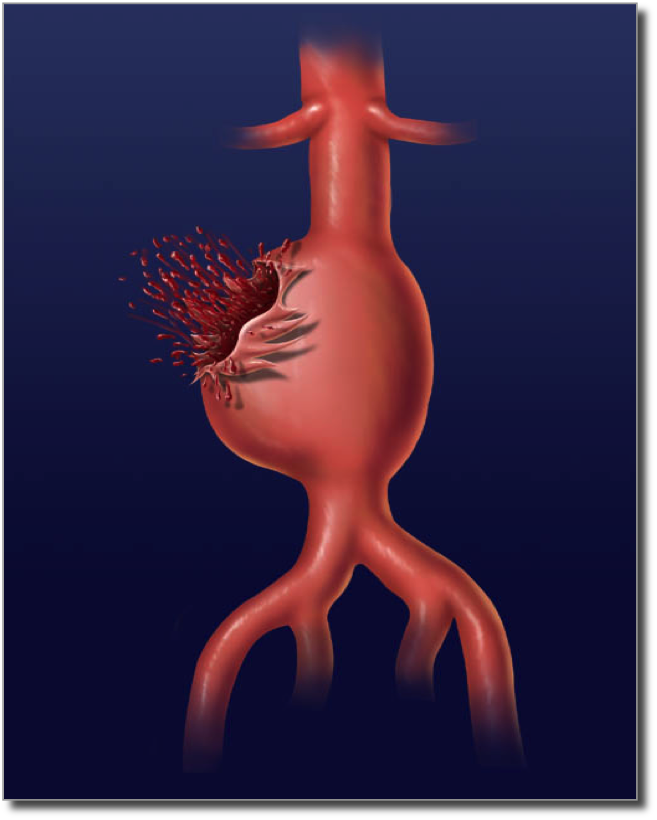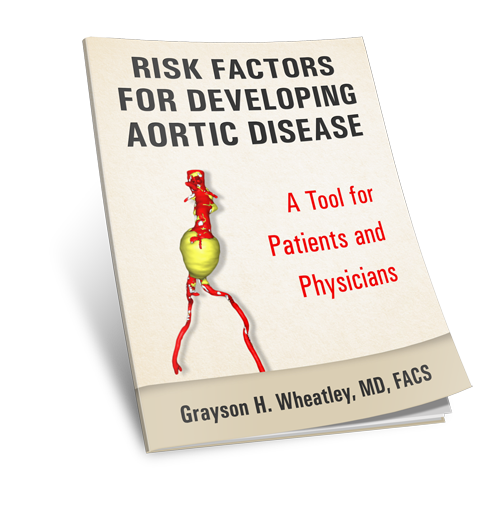Do you have an aortic aneurysm? The case for aortic screening
Do you have an aortic aneurysm?

One of the most unique features of aortic aneurysms is that they can develop without any warning signs.
Think about it: Most diseases or disorders develop slowly over time and once the disease has “progressed” to a certain stage, then the “effects” of the disease manifest themselves. This is the period when someone goes to the doctor because they aren’t feeling well or have a specific complaint (i.e. “my right hip hurts” or “I felt a new lump”).
Once the complaint is brought to the attention of a physician, a workup ensues and a search for the cause of the complaint is initiated. In some cases, this could be a simple blood test to check or involve more extensive testing.
After the results of the testing are complete, the diagnosis is confirmed and treatment is started.
However, the disease model for aortic aneurysms is almost always different than this standard model.
How do you find an aortic aneurysm?
With aortic aneurysms, the slow expansion of the aorta develops over years and the localized expansion of a segment of the aorta doesn’t cause any noticeable symptoms. Blood can still flow through the aneurysm and the swelling does not cause pain. In addition, since aneurysms are located deep internally, it is almost impossible to feel an aneurysmal bulge. In skinny individuals, a trained physician can push on the belly and feel an enlarged aorta. Most patients don’t know what to look for and doesn’t appreciate the physical bulge in their stomach region.
The aortic aneurysm can grow to significant sizes before causing problems. When an aneurysm does cause a problem, it is often catastrophic. That is because the aneurysm “bursts” or ruptures which causes internally bleeding. This bleeding can sometimes cause instantaneous death or, if not too significant, can be treated with an emergency procedure.
Nevertheless, the point here is that aortic aneurysms are “silent killers”. As a result, the way to prevent patients from dying from aortic aneurysms is through awareness and screening programs.
Aortic aneurysm screening
Screening for aortic aneurysm disease can save lives.

There are certain groups of people who are at high risk for developing aortic aneurysms, and it is in these populations that screening has been shown to prevent death from aortic rupture.
A “high-risk” group of patients means that there are certain risk factors that that people possess that increase their risk for developing an aortic aneurysm. People who possess 1 or more of these risk factors are termed “high risk” and should be screened (see below).
Risk factors such as age >65 years of age, a history of smoking, a history of hypertension (high blood pressure) even if being treated with medications and a family history of aortic aneurysms are just some of characteristics that make one person more likely to develop an aortic aneurysm as compared to another.
To better understand your individual risk factors for developing aortic aneurysms, you can download a free copy of my report “Risk Factors For Developing Aortic Disease” by signing-up for my newsletter.
If you or someone you know has one or more of these risk factors then it is worth your while to discuss this with you physician and get screened for an aortic aneurysm.
What is screening for an aortic aneurysm?
Screening for an aortic aneurysm refers to a simple diagnostic test that can be performed in high-risk patients (or any person for that matter).
An abdominal ultrasound refers to a simple test that takes about 10 minutes to perform. The test is very similar to a “sonogram” that pregnant women receive. Using ultrasound, the abdominal aorta (in the stomach region) can be imaged and the size of the aorta can be measured. Patients need to be fasting for about 4 hours prior to the test. This is because any air in the bowels will prevent the sound waves emitted from the ultrasound probe placed on the surface of the stomach region from getting down to the aorta. The bowels are located above the aorta. There is no radiation associated with an ultrasound test.
If the aorta is enlarged then a referral to an aortic specialist is best. Additional testing may be needed.
As you recall from prior posts, the aorta starts in the chest and runs the length of the torso. Ultrasound cannot see the entire aorta in the chest. The only accurate way to see the aorta in the chest is a CAT scan. However, a CAT scan does involve radiation and we don’t believe that subjecting all high-risk patients to a CAT scan is worth the radiation risk. That is why we only screen the abdominal aorta - it can be seen using ultrasound which lacks any radiation dose.
If a patient does have an abdominal aortic aneurysm, we will order a CAT scan of the chest to look for other potential sites of aneurysm formation.
AAA Outreach

There are several non-profit organizations which help set-up and coordinate aortic screening events.
Of course, family doctors can recommend that a high-risk patient be screened, but some patients want to take matters into their own hands. As a result, it is possible to receive an aortic screening test through a “screening event”. These screening events allow patients to get a simple aortic aneurysm screening ultrasound without having to go through their physician.
One such organization is AAA Outreach. They help sponsor and arrange free screening events across the country so that people can get screened.
From their website:
Inspired by AAA advocate Sheila Arrington, who lost her father to a ruptured AAA and has a strong family history herself, our goals are to: Raise public awareness about AAA Provide free screening services to at-risk populations Create a support network for individuals and families impacted by or at risk for AAA
I recommend that you check them out at their website HERE.
They are also on twitter: @AAAOutreach
If you feel that you are interested in getting screened, please contact them and they can provide information about their program.
Summary
In summary, not everyone’s risk for developing an aortic aneurysm is the same. Because aortic aneurysms develop slowly overtime - and without any symptoms - it is frequently impossible to identify an aortic aneurysm without a screening test. There are certain people who are at “high risk” for developing an aortic aneurysm based upon certain medical factors. People at high risk for developing an aortic aneurysm can be screened. Screening for an aortic aneurysm involves a simple abdominal ultrasound which takes 10 minutes and avoids any radiation. AAA outreach is an organization that can help provide information about free aortic aneurysm screening events near you.
Was this post informative?
Subscribe to my newsletter to learn more about the aorta, its diseases, and how to treat them.
Comments
Share your thoughts below — I try to get back to as many comments as possible.